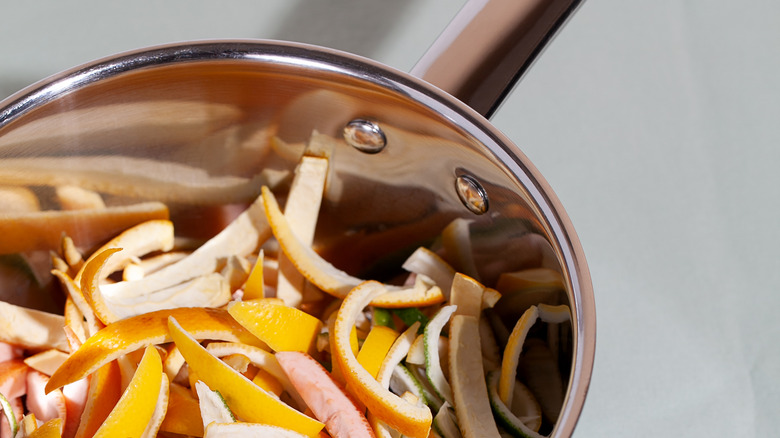Can You Get Sick From Eating The Grapefruit Peel?
Grapefruit's sweet yet sour characteristics are popular for many reasons. The fruit's juice can be used in various recipes, and it is said to have many health benefits. Its punchy flavor blends well into cocktails, candies, and baked goods.
According to Medical News Today, grapefruit is rich in vitamins and minerals and contains few calories. It is also low on the glycemic index, making it a popular fruit among dieters and safe for some diabetics to consume. To reap its health benefits, you must drink 100% grapefruit juice and avoid the high-sugar fruit juice mixes (via Real Simple).
According to Well + Good, eating grapefruit provides health benefits such as immune support, is high in antioxidants, contains calcium and phosphorus, and may help prevent arterial wall buildup and diabetes. That's one powerful fruit! So, we know that grapefruit juice is healthy, but what about the peel? Is grapefruit peel safe to consume?
Grapefruit peel benefits
Grapefruit peel isn't only safe to eat but also good for you. We aren't saying to start munching on the peels; they may taste a bit bitter. But, there are health benefits from incorporating the peels of this citrus fruit into your daily diet. According to Live Strong, grapefruit peel has more fiber than pulp does. Its essential oil contains phytochemicals and vitamin C, which provide antioxidants to fight free radicals (pollutants). Some elements in grapefruit may help fight cancer (via Pub Med).
Healthfully states that grapefruit peel also contains skin benefits. The enzyme found in these peels includes the enzyme bromelain, which helps gently exfoliate the skin and balance its pH. Grapefruit peel also provides anti-inflammatory benefits and can be used to soothe insect bites and other skin irritations. Grapefruit peel essential oil provides these benefits when massaged over the infected area. Always consult with your doctor before using grapefruit as a skin remedy, especially if you have sensitive skin.
Ways to consume grapefruit peel
Grapefruit peel can be added to savory dishes, vinaigrette salad dressings, marinades, or grated into yogurt or salads. You can also make a dressing by combining mayonnaise with a splash of grapefruit juice (via Live Strong). Healthy Eating states that grapefruit peel zest can be sprinkled over seafood and vegetables for a fresh zing.
Another way to get your grapefruit fix is to make candied grapefruit peel. Keep in mind that it does contain sugar, but the sweetness helps offset the bitter taste, making it more palatable. According to Healthy Eating, the peel contains zero fat, no cholesterol, and 25 calories per piece. Bon Appétit states to remove the peel from the grapefruit and slice it into long, thin strips. Blanch the strips twice in boiling water, drain, then simmer in sugar and water for 15-20 minutes or until translucent. When the liquid is almost completely evaporated, cool the strips on a rack for two to four hours. Finally, toss the peels in sugar and enjoy!
According to the FDA, grapefruit may interact with some medications, so always consult with your doctor before consuming grapefruit, grapefruit juice, or its peel.


